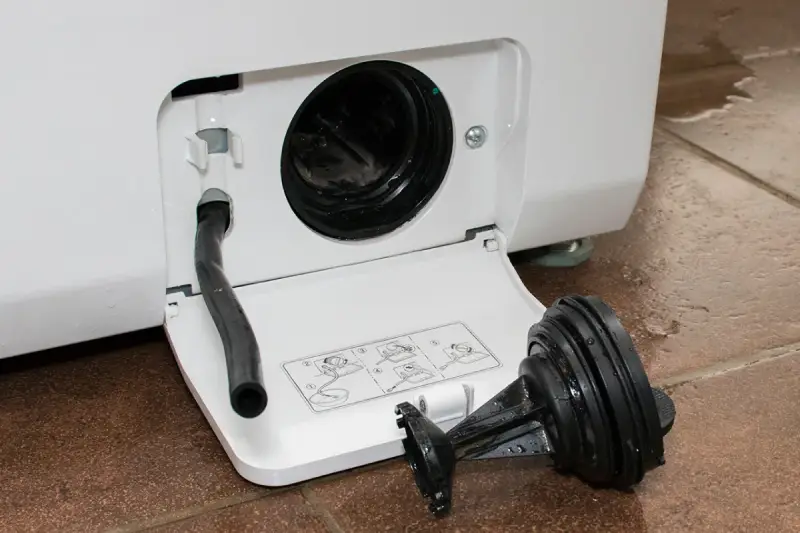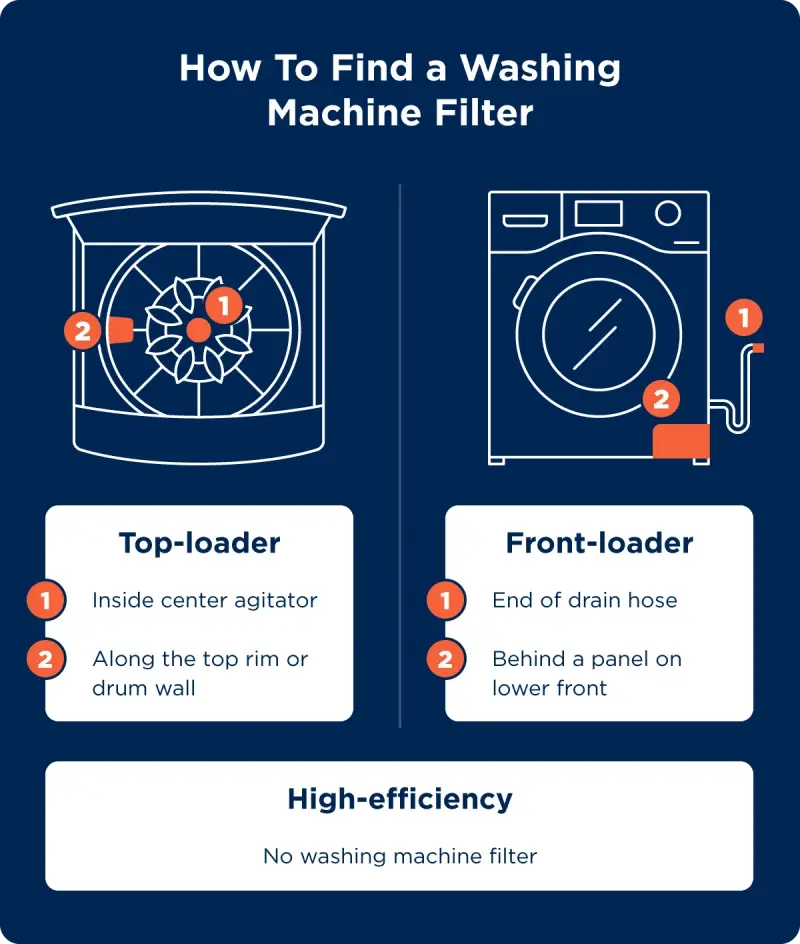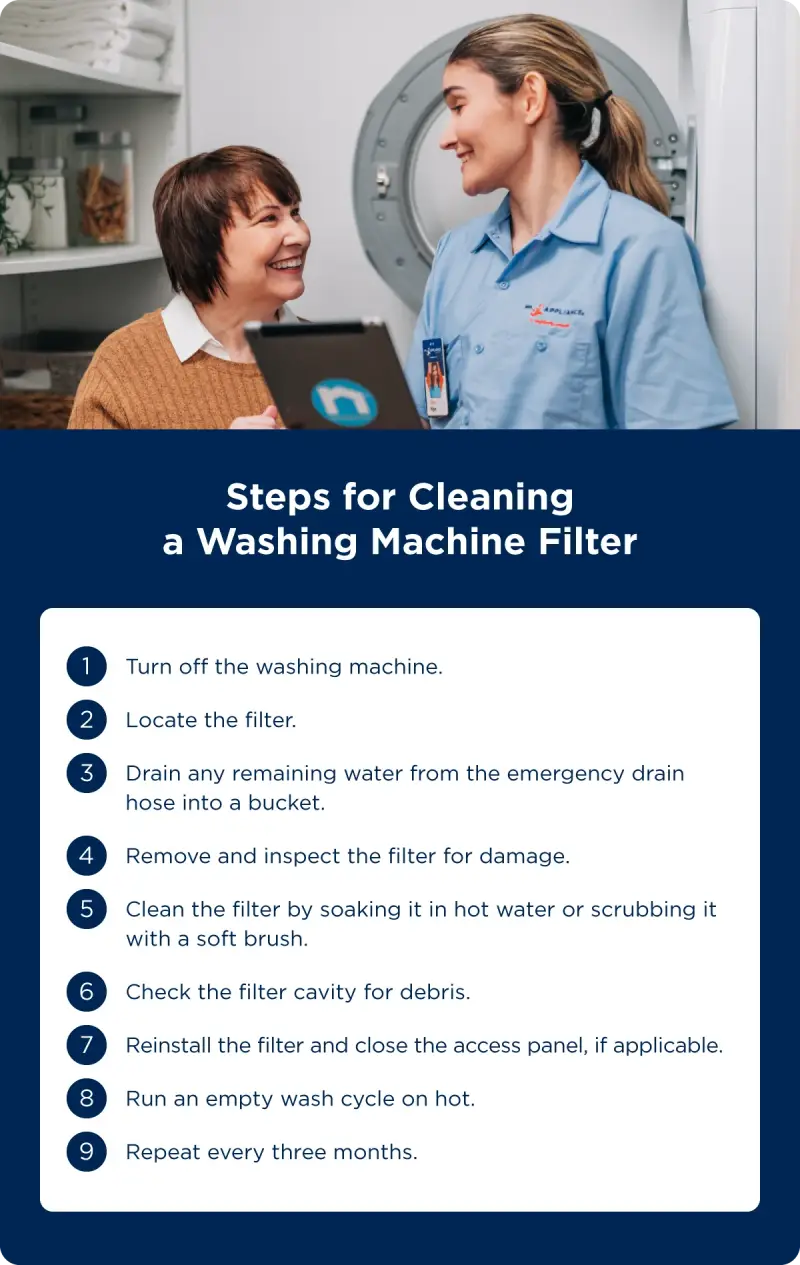How To Find and Clean Your Washing Machine Filter

A washing machine filter acts as a lint trap to remove fuzz, hair, and other debris from your clothing and linens. Check inside or along the exterior of your washer to locate and determine if your machine has a filter. To prevent buildup and prolong your machine’s lifespan, clean your washing machine filter at least every three months.
You know to clean your dryer’s lint trap with every use, but did you know you may also have a washing machine filter that requires similar routine cleaning to prevent buildup? If your clothes come out of the wash with a light coat of lint, then your washing machine’s filter may already be clogged, and it’s time to clean it.
Some washing machine filters are removable, while other washers have mesh lint traps. Both styles serve the same purpose: to keep lint off your clothes and ensure good water drainage. However, only a clean filter or trap can do this.
Thankfully, you can easily fix lint and debris clogs, and we’re here to guide you through how to clean your washing machine filter.
Where Is the Washing Machine Filter?
The location of your washing machine’s lint filter depends on the age, brand, and whether it’s a front-load vs. top-load washing machine. Top-load washer lint traps are usually located inside the drum, whereas filters in front-loaders are typically accessed from the exterior. Some modern, high-efficiency machines may not have a filter at all.
Refer to the owner’s manual for specific instructions, or physically check the following areas based on your machine type — after you’ve turned your machine off.

Top-Loader Washing Machine Filter
You can typically find filters in top-loader machines in two places: inside the agitator or along the top lip of the tub. Here are tips on how to locate a washing machine filter in a top-load washing machine:
- Inside the center agitator: If you have a top-loading washer, inspect the center agitator. The cover may be removable, revealing a lint trap inside. It may look like a fully or partially enclosed cylinder with pinholes along the sides.
- Inside the top rim or along the washer drum: Use your fingers to feel around the top lip for a round or rectangular screen. You can remove this screen to brush off built-up lint. Move slowly to avoid jamming your fingers against the washer drum, and keep a good hold on the lid to prevent it from falling on your hand while you’re investigating.
Front-Load Washer Filter Location
Front-loader washing machine filters may be located in one of two places as well. Unlike top-loaders, you can typically access front-loading washer filters from the machine’s exterior. Here are the two places to check if you have this type of washer:
- On the front of the appliance: A cylinder filter may be hidden behind a small hatch on the machine's exterior. These are often located in the front bottom right corner.
- At the end of the drainage hose: A small mesh screen may be fitted onto the hose that drains water out of the machine.
High-Efficiency Washing Machines
If you have a high-efficiency (HE) washer — whether front- or top-loading — your machine likely doesn’t have a washing machine filter. Instead, it relies on a self-cleaning pump filter to remove lint from the wash. High-efficiency washers may not have lint traps, but the water pump filter can still get blocked. Here’s how to clean the pump filter:
- Run an empty wash or self-cleaning cycle once a month to flush excess lint from the pump filter.
- If you notice your clothes come out of the wash still dirty, check your water pump filter.
- Locate the small hatch on the lower front of the appliance.
- Open the hatch to remove anything that might be clogging the water pump filter, like buttons, coins, or even socks.
- Check the pump regularly for blockages to help your washer function properly.

How To Clean a Washing Machine Filter
If you notice lint on your freshly washed clothes or that your washing machine smells unpleasant, it’s time to inspect your washing machine filter for buildup. Routinely cleaning your filter will help with efficient washer operation, better drainage, and reduced lint deposits on clothes.
Here’s how to empty the lint trap in a washing machine:
-
Turn off the washing machine. Ensure your machine is not running before attempting to remove the filter. Better yet, unplug the machine first.
-
Locate the filter and remove the access panel cover. Refer to the owner's manual for specific instructions on your exact model. If you don’t have the manual handy, search the following areas for the filter:
- Top-loaders: Check along the top lip of the washer drum. If you don’t feel one along the rim, the filter may be inside the center agitator. Remove the fabric softener dispenser and agitator cap if your model has them.
- Front-loaders: Filters may be located behind a small hatch in the lower corner of the front of your machine or at the end of the drainage hose. The cover may have a push-to-release latch or require a thin tool like a coin to wedge open the door.
-
Place a dish or bucket underneath and drain any remaining water from the emergency drain hose. If your dish fills quickly with water, replace the cap and empty the dish. Repeat this process until the water stops flowing. Have a towel handy to clean any accidental spills. This step is only necessary for front-load washing machines.
-
Remove and inspect the filter. Unscrew or slide the filter out of its compartment. If your front loader has a mesh filter on the drain hose, you do not need to remove it. Look for debris and damage. Any buildup will be obvious, but be sure to check for cracks or broken parts carefully. If you identify any damage, schedule a washing machine filter replacement with your local Mr. Appliance®.
-
Clean the filter.
- For removable filters, soak the screen in a mixture of hot water and dish soap for 10 minutes to clear away built-up residue.
- For secured filters, clean away the lint with a soft brush.
- If the trap is disposable, replace it when it becomes clogged.
-
Check inside the filter cavity to see if your filter is removable. If the compartment has lint or sticky soap residue, use a soft brush to clean it out.
-
Reinstall the filter and close off the access panel. Slide or twist the filter back into place and return the cap or shut the hatch. Double-check that you’ve secured the emergency drain hose back to its position before closing, if applicable.
-
Run an empty wash cycle using hot water. If your machine has a pre-programmed cleaning cycle, you can run this instead.
-
Repeat at least every three months to remove the sticky layer of lint, detergent, and fabric softener from your washer lint trap.
If you still notice that your washer won’t drain or isn’t getting enough water, you may have a plumbing pressure issue. Contact your local Mr. Appliance to have it checked out.
Help Your Washing Machine Last Longer
Regular washing machine maintenance can help your appliance last longer and perform better. Make inspecting and cleaning your washing machine filter part of its routine care.
If you’re in need of washing machine repair or maintenance, your local Mr. Appliance® service professionals have the experience to get your machine — or any other household appliance — working properly again. Schedule a service online today, or give us a call.
We’re looking forward to providing you with outstanding service.
FAQ About Washing Machine Filters
If your clothes come out of the washing machine with a linty film, our appliance experts have answers to some of the most common washing machine filter troubleshooting questions.
How Often Should I Clean a Washer Filter?
Washing machine filters should be cleaned at least every three months. If you run your machine daily or frequently wash heavily soiled items — like food-crusted toddler clothing or fur-covered blankets — check to see if your filter needs cleaning at least once a month.
Do All Washing Machines Have Lint Traps and Filters?
No, not all washing machines have filters. Many modern, high-efficiency machines use a self-cleaning pump to remove lint instead of a traditional lint trap. Look for a symbol shaped like a whirlpool with a lowercase “he” inside the symbol. If your machine has this symbol, it is a high-efficiency washer and does not have a lint trap.
Instead, to clean these units, run the washing machine on its clean cycle while empty at least once per month.
Where Is the Filter on a Top-Load Washing Machine?
If your top-loading washer has a lint trap, it is likely inside the central agitator. To access it, remove the cover on the top of the agitator. This exposes the hollow center of the agitator and the lint trap. Other top-load models may have lint traps along the rim of the washer drum.
How Long Does a Washing Machine Filter Last?
With routine cleaning, your filter should last for the entirety of your washing machine’s lifespan. However, replacing this part may be necessary if you notice:
- Damage to the filter
- Severe clogs
- A change in the filter’s ability to trap lint
Is a Washing Machine Filter Required?
Yes, a washing machine filter is necessary unless you own a high-efficiency machine with a built-in cleaning system. Without a filter, you risk lint and debris buildup, which can result in plumbing or washing machine issues or damage.
What Happens If You Don’t Clean the Washing Machine Filter?
Putting off cleaning your washing machine filter can cause the same issues as not using a filter altogether. Lint, hair, and food particles will build up inside the filter, causing a significant clog. Clogs may lead to drainage problems, washing machine leaks, and other potential long-term damage.
Contact Mr. Appliance
Is your lint trap damaged? Find your local Mr. Appliance® to get your appliance inspected and your lint trap replaced. Once we’ve identified the issue with your washing machine, we’ll order and install the replacement part as quickly as possible. Contact Mr. Appliance today!
This article is intended for general guidance only and may not be applicable to every situation. You are responsible for determining the proper course of action for your property and your situation. Mr. Appliance is not responsible for any damages that occur as a result of any advice or guidance derived from blog content. For the most accurate guidance, contact an independently owned and operated Mr. Appliance business for a professional custom and on-site assessment.
 Click to call
Click to call


